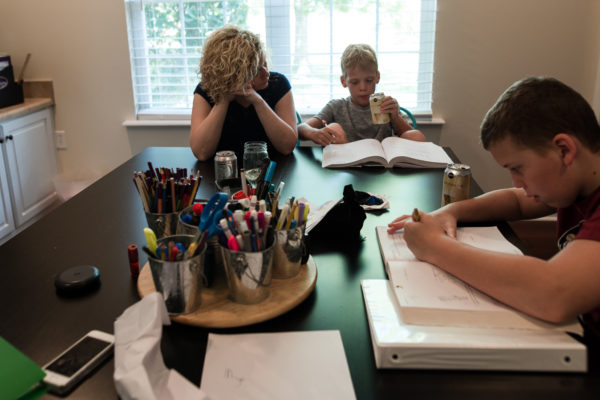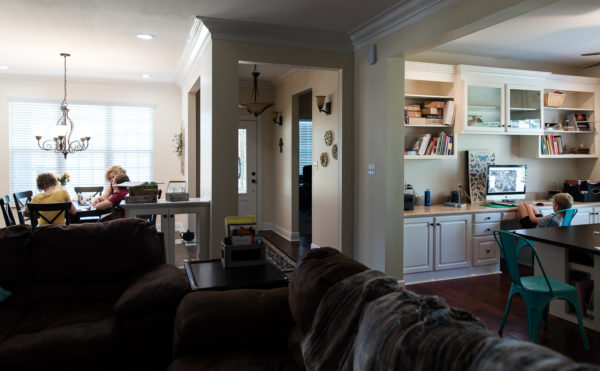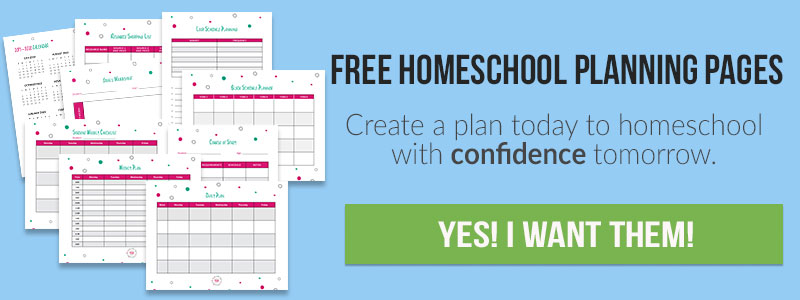
Hey, I get it. I love planners myself. I have the billion colored pens, disc-bound pages, bullet journals, stickers, washi — all of it.
Planners are just plain fun. And it is easy to get caught up in the fun of making a homeschool planner.
It’s also easy to look for a solution to your problem that you can just buy already.
Homeschooling not going as you had envisioned?
Inconsistent with which days you do school and easily pulled off track?
Second-grader not reading yet and you are feeling stressed about it?
Ordered pizza yet again because the only thing in the kitchen at 5:00 PM were some stale cheerios and a bottle of crusty-top ketchup?
The solution must be to do what those organized people do — buy a planner and fill in the boxes with everything you are going to do right from.now.on.if.it.kills.you. Mama, you are just setting yourself up to fail. The planner is not the answer to your problem.
Planning is.
Whoa, wait a second. Aren’t they the same thing? Nope, they are not.
Three ways the planning process is different than just filling in a planner
There is a ton of pressure that comes with filling in one of those pre-made planners you spent a lot of money on. You want everything to look just so and be neat and tidy.
Which limits your ability to plan well, quite honestly. Homeschool planning should be messy business because life is messy business. You might need to make a draft or two, cross things out, and crumple up the page and start again.
Planners you buy don’t allow you to do that. In fact, they often constrain you from doing the most important parts of planning at all.
Good homeschool planning is vision-based
Homeschool planning should always start with making a vision statement. Then that statement should be kept handy and revisited often through the planning process and the school year. Most pre-made homeschool planners do not even address this step, nor do they leave a spot inside to store this vital document.
A vision for your homeschool is not about what you want your child to have accomplished in 20 years but instead, it is a statement of intent about what the day-to-day atmosphere in your home looks like.
- What is important to you and your spouse about education?
- What things do you want to prioritize in your homeschool?
- How do you want to spend your time as a family?
Without knowing these things it is easy to fill those planner grids with activities and plans that will not help you to create the kind of education you want for your kids.
I love this quote:
[box] Rowing harder doesn’t help if the boat is headed in the wrong direction. -Kenichi Ohmae[/box]
Good homeschool planning is personal
Homeschool planning is not one size fits all. This means that there is a good chance many of those pages and boxes in that fancy planner won’t get used or will be washi-taped over so you can fill the space with something else.
But it goes deeper than that. Your needs and your priorities are going to be totally different from the next homeschool family.
Taking time to lay out those needs, and even make some goals, is an early step in the process that often gets overlooked.
Start with a series of questions for each person in your family (including mom);
- What is already working well?
- What are this person’s strengths?
- Where do we need to focus our efforts this year to help this person grow?
Then create goals based on behaviors and not outcomes — measure what you’re doing in the day to day instead of what box gets checked off at the end of the year.
Good homeschool planning is flexible
Ok, this one is perhaps my biggest beef with pre-made homeschool planners. Those darn weekly grids.
Because my life doesn’t fit neatly in the little lines.
Being consistent is a priority around here but even so, we just can’t help when life happens. And writing out exactly what I think I will be doing the third week of September is like begging Murphy’s Law to mess it up.
This means that most people using these grided lesson plan pages begin to think that planning is the problem. That couldn’t be farther from the truth.
Planning is deciding what you are going to do when it is time to do the next thing. Which is why we should plan in flexible un-dated lists instead of rigid calendar-like grids.
Creating your lesson plans in lists by subjects means that some days you can do just the bare necessities and salvage a school day without worrying about messing up your plans.
It means that you are free to use creative scheduling to get more done and bring more peace to your day.
It means you are the master of your curriculum and not a slave to it.
Your problems will never be solved by buying the “right” planner
Here’s the deal. Your planner should fit your process — not the other way around.
It really doesn’t matter if you use a bullet journal, print your own planner, or plan on an app — choose whichever one works best for your personality.
But divorce the process of planning (the more important part) from the actual planner itself. When you do that you will start making plans that are actually useful and make your life easier.
Pinky promise.
Want some big picture planning forms you can scribble on, crumple up, and print again? Download ours for free (vision form included).
- Juggling Big Life Changes and Homeschool - June 17, 2025
- Which Homeschool Schedule Actually Works for You? - June 3, 2025
- How to Keep Homeschool Consistent When Life Isn’t - May 20, 2025



